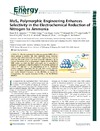Please use this identifier to cite or link to this item:
https://accedacris.ulpgc.es/handle/10553/74731
| Title: | MoS2 Polymorphic Engineering Enhances Selectivity in the Electrochemical Reduction of Nitrogen to Ammonia | Authors: | Suryanto, Bryan H. R. Wang, Dabin Azofra Mesa, Luis Miguel Harb, Moussab Cavallo, Luigi Jalili, Rouhollah Mitchell, David R. G. Chatti, Manjunath MacFarlane, Douglas R. |
UNESCO Clasification: | 221001 Catálisis | Issue Date: | 2019 | Journal: | ACS Energy Letters | Abstract: | The electrochemical N2 reduction reaction (NRR) offers a direct pathway to produce NH3 from renewable energy. However, aqueous NRR suffers from both low Faradaic efficiency (FE) and low yield rate. The main reason is the more favored H+ reduction to H2 in aqueous electrolytes. Here we demonstrate a highly selective Ru/MoS2 NRR catalyst on which the MoS2 polymorphs can be controlled to suppress H+ reduction. A NRR FE as high as 17.6% and NH3 yield rate of 1.14 × 10−10 mol cm−2 s −1 are demonstrated at 50 °C. Theoretical evidence supports a hypothesis that the high NRR activity originates from the synergistic interplay between the Ru clusters as N2 binding sites and nearby isolated S-vacancies on the 2H-MoS2 as centers for hydrogenation; this supports formation of NH3 at the Ru/2H-MoS2 interface. | URI: | https://accedacris.ulpgc.es/handle/10553/74731 | ISSN: | 2380-8195 | DOI: | 10.1021/acsenergylett.8b02257 | Source: | ACS Energy Letters [ISSN 2380-8195], v. 4, p. 430-435 |
| Appears in Collections: | Artículos |
Items in accedaCRIS are protected by copyright, with all rights reserved, unless otherwise indicated.
